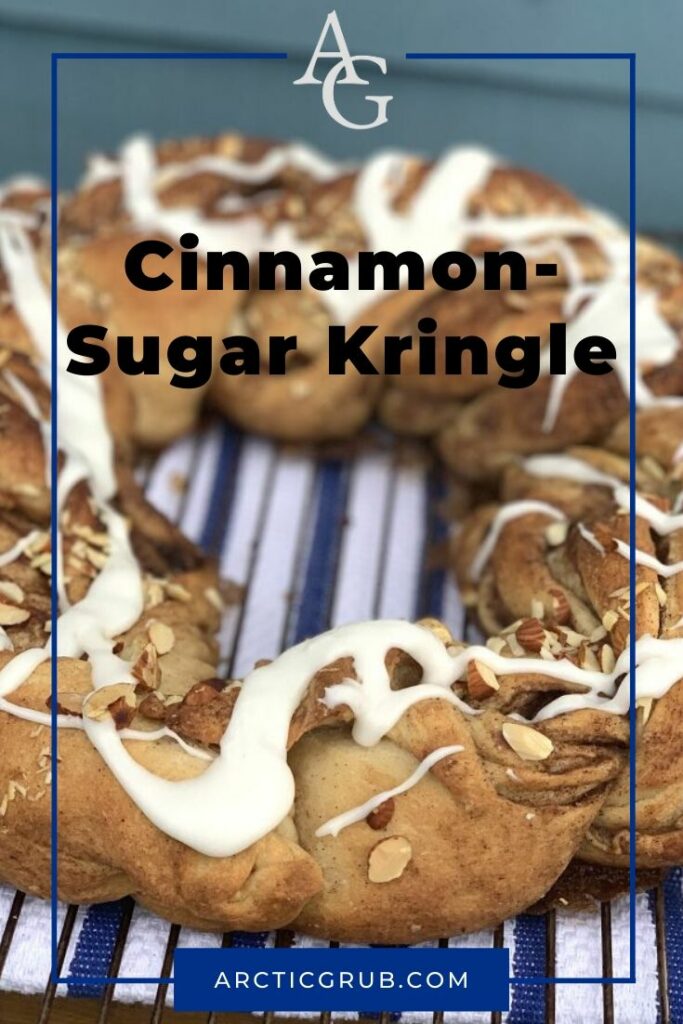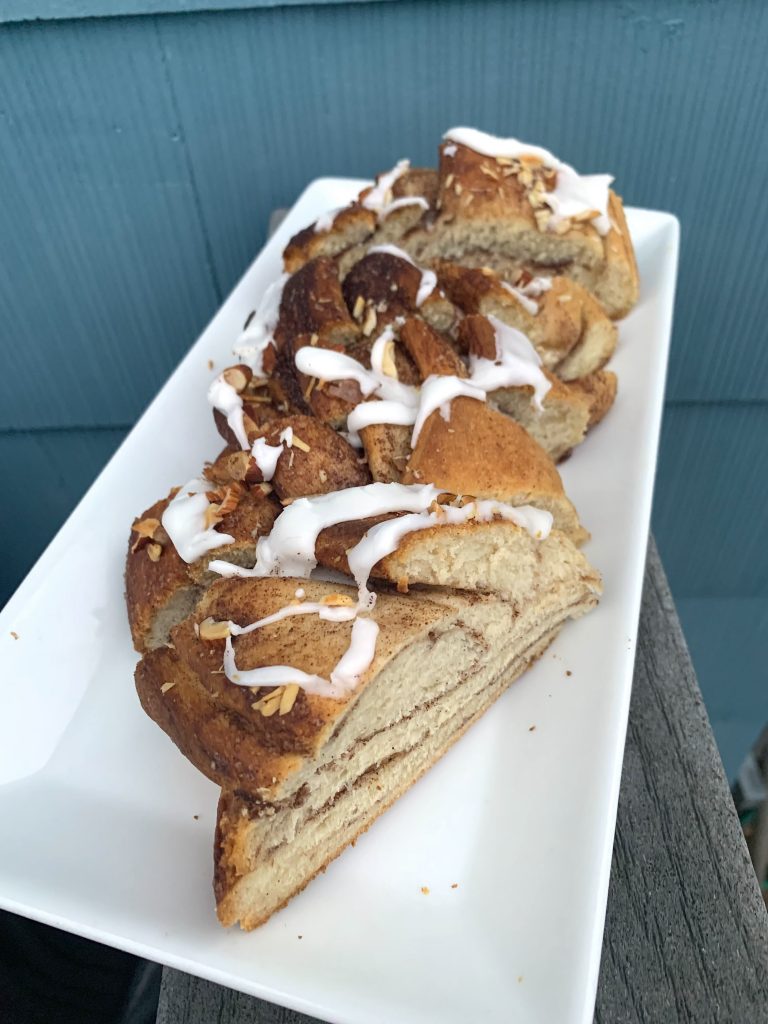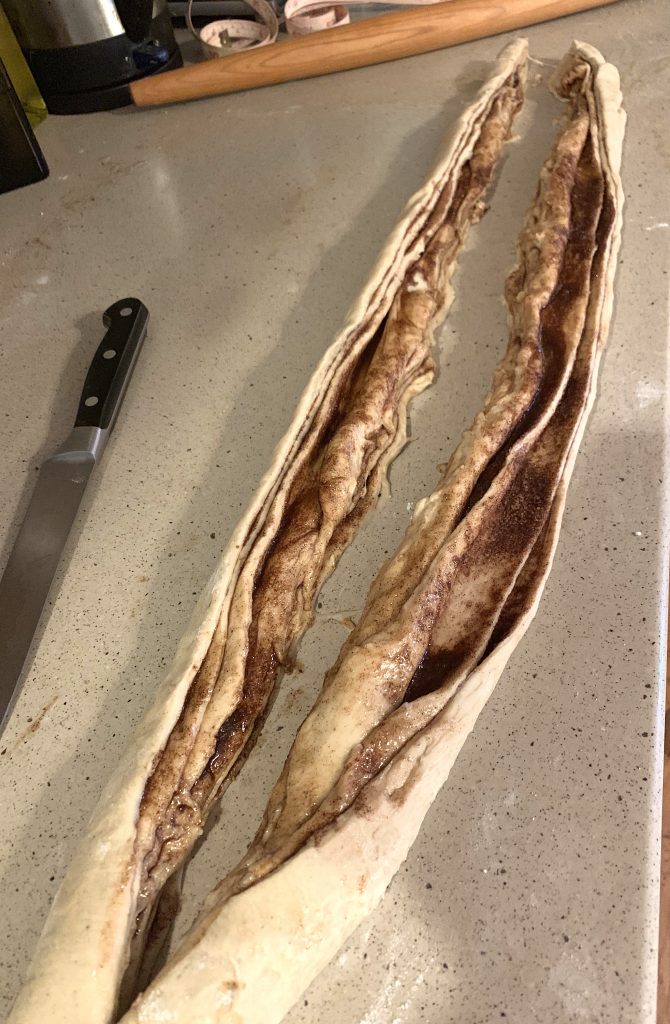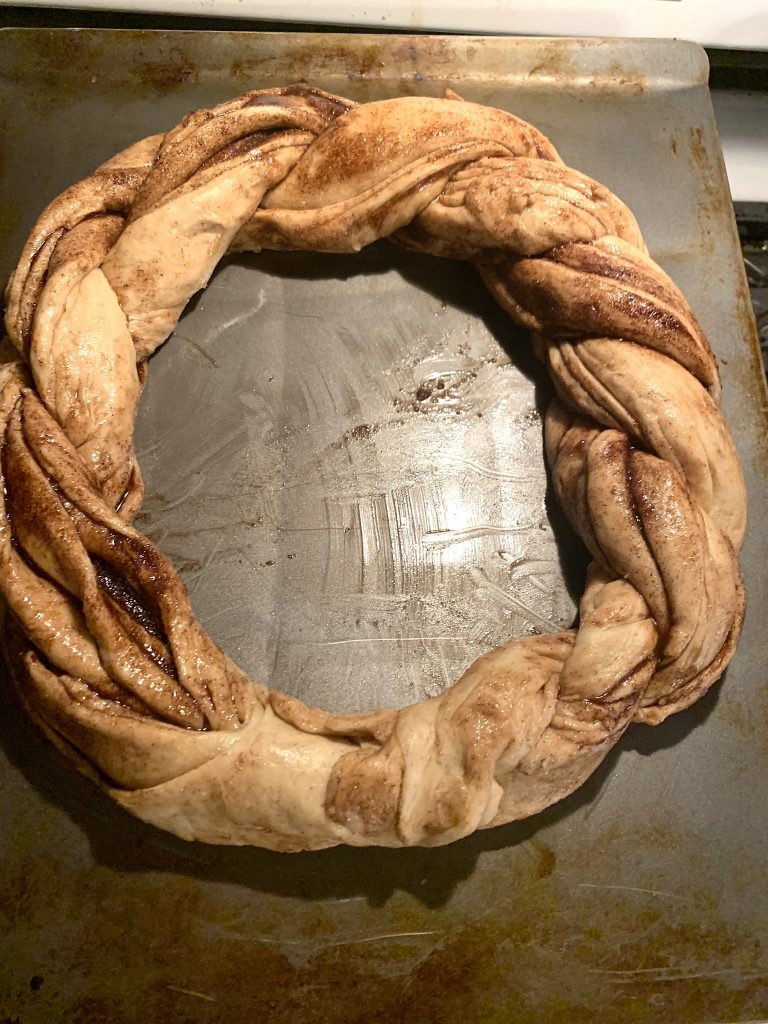*This blog post is an updated version of a previous blog post about kringler from 2014 but with a new recipe.
Who has heard of kringle?
The kringle is a popular Scandinavian pastry here in the U.S. among those familiar with Nordic cuisine. Oftentimes referred to as the Nordic pretzel because of its similarity in shape, it is said to have arrived in Scandinavian in the 13th century with the Roman Catholic monks.
Denmark might be better known for its kringler, and although I’m Norwegian must admit the Danes perhaps have a slight upper hand on coming up with creative varieties of this delicious knot-shaped pastry. The Danish are thought to be the ones who brought kringle to the United States too, so kudos to them for that!

The kringle symbol is one of the few ancient guild signs still used, and a traditional golden kringle sign is often hung outside bakery shops in Scandinavia. The shape is said to symbolize hands folded in a cross-like pattern across the chest to mimic the way people prayed in the Middle Ages, and not folding hands as is done today.
According to history, a 7th-century monk wanted to reward his students with small pieces of bread shaped in the same way the children kept their arms during prayer.
He named the baked good “pretiolas”—”a little reward”. The idea was quickly adopted across Europe, and the kringle became a symbol of luck and a long, prosperous life.
The kringle achieved particular fame in 1510 when Turkish troops attempted to dig their way into access Austria by digging their way underground through the wall into Vienna. The bakers, who were the only ones at work at that time of night, heard the noise and the attack was prevented as a result.
As a reward, the bakers received their own seal, which among other things included the kringle, and later became the bakers’ symbol.

The Norwegian word “kringle” is an old word, meaning ring or circle. In his introductory notes in his royal history saga stories, Snorre Sturlasson (an Icelandic poet and politician) described the creation of the world as “Kringla heimsins” (the world’s circle) in Norse.
His sagas have later become known as “Heimskringla”, a story about the Norwegian kings. I won’t go into more detail in this post, but who knew this pastry had such a long and interesting history?
Bergen is the place in Norway best known for its kringle.

The tradition most likely came from German or Dutch salesmen who conducted business on the dock in the coastal city (“Bryggen”). Perhaps this is where the connection to the German salty pretzel comes in? Regardless, kringler from Bergen was hugely popular all over the country. Fishermen from the north were not shy—they even transported kringler back home north in empty coffins!!
Both sweet and savory versions of kringle exist and many are filled with nuts, confectioners glaze, and pastry cream among many other delectable things.
In my area of Norway however, kringler are more often not filled, but rather plain. The pastry cream-filled version we refer to as “wienerbrød”. I will undoubtedly be writing about and posting some recipes for these tasty pastries in the near future!
I should also quickly mention the correct pronunciation of kringle is “Kring-LUH” – not “Kring-EL” which so many Americans say and I sometimes don’t connect the dots about which pastry they are trying to tell me about 🙂
I baked a perfect example of a kringle wreath over the weekend, filled with butter, sugar, and cinnamon, drizzled with a light confectioner’s glaze and sprinkles of almonds on top.
It’s the classic flavors of traditional pastries and although there are a million different varieties, there’s something just so satisfying about this simple combination. This dough is very light, soft, and airy, not too sweet, and just the perfect afternoon snack with a hot cup of coffee.
The kringle freezes very well too, and in fact, I did just that, otherwise I would have been snacking on kringle all week, and that just won’t help me get into shape for the spring and summer!
Just make sure you freeze the kringle the same day you bake it (and of course after you’ve had several slices!), then you can reheat it in the oven at about 300-325° Fahrenheit (150-175° Celcius) for about 10-15 minutes and it will taste just as fresh as the first day you baked it!

CINNAMON-SUGAR NORWEGIAN KRINGLE WREATH
For the dough:
5 ¼ cups (1 ½ lbs) or 650 grams all-purpose flour
1 ½ cups (3 ½ dl) non-dairy milk (almond, soy, or cashew work well)
2 tsp active dry yeast
½ cup (115 grams )sugar
1 stick (1/2 cup) /113 grams cold vegan butter like Earth Balance, diced
For the filling:
6 tbsp vegan butter, melted
2 tbsp cinnamon
1/3 cup (75 grams) sugar
Extra vegan butter (melted) for brushing the dough
For confectioner’s glaze:
1 ½ cups (150 grams) confectioner’s sugar
about 2 tbsp water
1/3 cup (20 grams) sliced almonds, for garnish
To make the dough:
Add all the ingredients in the bowl of a stand mixer, with the exception of the butter. The milk doesn’t have to be warm, you can add everything in cold. Fitted with the dough hook, knead the dough on low for about 10 minutes. You may need to add a little more milk if the dough seems dry, or more flour if it seems too sticky.
After 10 minutes, add the diced butter and knead for another 10 minutes, until you have a smooth dough that releases from the side of the bowl. Again, a few tbsp of flour might be needed to just pull it all together.
Once you have a firm, smooth ball, cover it with a clean towel and let it rise for about 2 hours.
On a clean work surface, sprinkle a little flour and roll out the dough until you have a rectangle that’s about 25 inches (60 cm) long. Brush the melted butter on the surface, and sprinkle the combined sugar and cinnamon evenly over it.
Start folding the dough from the bottom and the widest part until you have a link (much the same way as you make cinnamon buns), place the folded edges facing down.
Using a knife, cut the link in half lengthwise, leaving just 2-3 inches intact at the end, and fold one end over another, “braiding” the links together where the exposed cut side with the cinnamon filling will be facing up.
This can be slightly messy/tricky at first but it will work, I promise!

Shape the link into a circle, and transfer to a greased baking sheet. Place a clean towel on top and let it rise for another 45 minutes.

In the meantime, heat the oven to 400° Fahrenheit (200° Celcius).
Brush the kringle with the remaining butter and sprinkle on the chopped almonds.
Place the kringle sheet on the middle rack and bake for about 20-25 minutes until golden on top. Place on a cooling rack, and make the confectioner’s glaze while you wait for it to cool down.
In a small bowl add the confectioner’s sugar, and add in the water 1 tbsp at a time until you get a thick paste. I like to add the paste into a piping bag, and just pipe out some circular patterns on the kringler, but you can also just use a spoon or fork.
Decorate with the glaze and serve with your favorite hot beverage!





Loved your post. Just new to your mailing list. I am not vegan but I may just try making kringla your way. I have my very plain kringla for 50 years for family and friends. Everyone looks forward to Christmas when I make them.
I did not know the history of the kringla. Very interesting. I do a monthly blog for family and friends. My web page is under construction where I will post my blogs soon. I will pass on this information to them in the future and tell them about your fantastic webpage.
Again thanks for writing this one.
Hi Nelson,
Welcome to my community, I’m so glad you are here! Thrilled to hear you liked my blog post, most of my followers are not vegan but “plant-curious”, as I like to call them, and my focus is really as much on Norwegian history as it is on the actual recipe. Many are lactose intolerant these days and/or would like to try out recipes with less meat and dairy so I hope I can serve as an inspiration for trying out something different! They are still very classic in both the way the dishes are done and taste – I’m all about keeping it authentic! 🙂 Thanks again for your kind note and I look forward to staying in touch!
I, too am Norwegian and have many memories of wonderful meals made by my Norwegian grandmothers. I have been introducing my Norwegian recipes and traditions to my husband who has embraced them with gusto. Thankfully he loves fish as much as I do and it’s on our breakfast table often. I was so happy to find your blog and recipes and have tried some of your delicious alternative ways of remaking old favorites. This kringle is very different from my family’s recipe but will be on tomorrows table with steaming hot coffee! Thanks for sharing. Paula
Hi Paula,
How nice to hear from you, thanks so much for your kind note and for telling me a bit about your background – I’m so happy you found my blog too! I hope you will stay in touch and that my kringle recipe will work out for you and please your palate! Happy baking! 🙂 Sunny